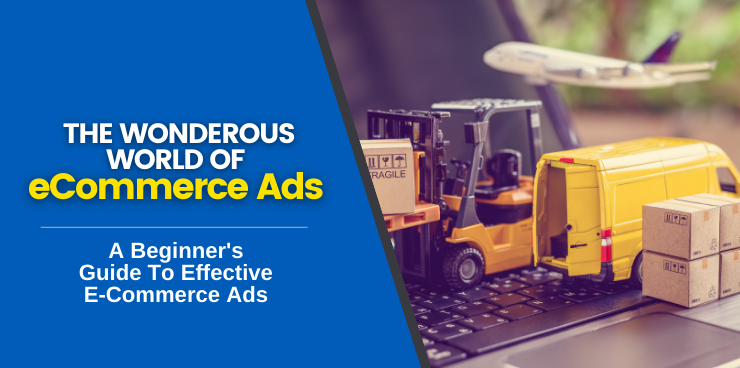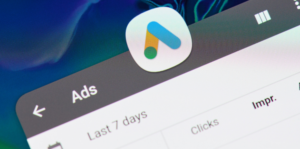The online world is an expansive place of opportunity and profitability for business owners. We have the power to create targeted, personalized, and interactive ads that are designed to be, quite literally, in the palms of our audiences’ hands.
Not only that, we have the unique ability to track eCommerce ads to see which ones are working and which ones need to be tweaked.
As more and more residential home service products become available online, eCommerce ads will become more and more essential for businesses to employ.
Since online shopping tipped to the majority in December of 2019, it’s crucial that eCommerce ads become more strategic than ever before.
To adapt to this new digital landscape, we’ve compiled this starter guide to eCommerce ads.
This eCommerce ads guide will outline the best ways to enhance your eCommerce marketing, what platforms are most effective for advertising campaigns, and more.
What Are eCommerce Ads?
eCommerce ads are a form of online advertising that helps businesses promote and sell their products or services online without the intervention of a human being. eCommerce advertising can take many different forms, including banner ads, search engine marketing (SEM), social media advertising, and email marketing.
There are many benefits to eCommerce advertising, including the ability to reach a large audience, the ability to target specific demographics, and the ability to track results. eCommerce ads can be an effective way to boost traffic to your website and increase sales.
If you’re interested in eCommerce advertising, Wizard of Sales® can help you maximize profits with your eCommerce ads campaign. We’ll work with you to identify your goals, target your audience, and create ads that are designed to achieve results.
Book a demo with us today to get started!
7 Best Ways To Improve Your eCommerce Ads Today
Figuring out how to do something on the internet is a lot like dating — you have to kiss a lot of frogs to find your prince.
Luckily, we’ve got Prince Charming waiting for you.
Here are seven of the best ways to improve your eCommerce ads today.
eCommerce Ad Personalization
eCommerce Ad Personalization is the process of customizing eCommerce ads to each individual customer based on their specific needs and wants. This could include using data from past interactions, demographics, interests, and more to create a highly personalized ad experience.
There are a few different ways to go about eCommerce ad personalization:
- Retargeting: This is when you show ads to people who have already visited your eCommerce store or website.
- Product recommendations: These are based on the products that a customer has viewed or purchased in the past.
- Lookalike audiences: This is when you target people who have similar characteristics to your best customers.
By using eCommerce Ad Personalization, you can create a much more relevant and targeted ad campaign that is more likely to result in conversions.
Mobile Device Optimization
Everyone is on their phones these days, and that includes your customers. Making sure that your online shopping ads are mobile-friendly will not only improve your click-through rates but also ensures that your customers have a positive experience with your brand.
To optimize your eCommerce ads for mobile, start by making sure that your ad is responsive, meaning that it will adjust to fit any screen size. You should also use short, concise copy that is easy to read on a small screen. Finally, include a call-to-action that is clear and easy to click on.
Post-click User Experience
A post-click user experience is when a customer clicks on an eCommerce ad and is then taken to a landing page. This is where they will find more information about the product or service that they are interested in.
It is important to have a good post-click user experience because it will help make sure that customers are getting what they had expected when they click on your ad.
There are a few things that you can do to improve your post-click user experience:
- Make sure that your landing page is relevant to the ad that was clicked on. This means that the content on the landing page should be related to the product or service that was advertised.
- Use strong calls to action on your landing page. This will help encourage customers to take the next step in the buying process.
- Provide easy navigation on your landing page. This will help customers find what they are looking for quickly and easily.
Conversion Rate Optimization
To optimize your conversion rates, your eCommerce business needs to create compelling ads that tell a story, capture the hearts of your top prospects and make them loyal to your tribe.
You can do this by creating messaging that’s in sync with your brand, understanding what motivates your audience and making it easy for them to take the next step.
Using Google AdWords, you can set up eCommerce conversion tracking to see how well your ads are performing. You can also use AdWords to create eCommerce remarketing lists, which allows you to show ads to people who have already visited your site or made a purchase.
Targeting and Retargeting
Targeting is a process that helps you to identify potential customers for your product or service. It involves researching your target audience and understanding their needs. Once you know who your target audience is, you can start to create content that appeals to them.
Retargeting is the process of showing ads to people who have already shown an interest in what you’re selling. This can be done by tracking the cookies on people’s browsers or their IP addresses. Retargeting allows you to effectively keep your brand in front of potential customers, even if they don’t purchase from you immediately.
Both targeting and retargeting advertising techniques are important methods for improving your eCommerce ads. By understanding your target audience and creating relevant content, you can make sure that your ads are seen by the people who are most likely to convert.
AI and Machine Learning
We’re in the age of the machine, and there’s no turning back. Businesses are starting to fully understand how artificial intelligence (AI) and machine learning can be used to improve various areas of their operation — including eCommerce advertising.
In the case of eCommerce ads, AI and machine learning can be used in several ways. For example, these technologies can help you create more personalized ads, optimize your ad spend, and track customer behavior.
Additionally, AI and machine learning can help you automate the entire eCommerce ad process — from creating ads to analyzing results. This makes your job a whole heck of a lot easier and frees up your time to focus on other areas of your business.
Social Commerce
Social commerce is essentially using social media platforms to improve your eCommerce ads. This allows you to target a wider audience with your ads and reach potential customers that you may not have otherwise had access to.
When you engage with your audience on social media, you also create a rapport that builds trust with potential customers. Since social media channels are such expressive, casual platforms, you will be seen as more relatable and authentic which will make people resonate more with your brand.
Simply commenting on someone’s post, cracking a joke, or responding to a customer’s direct message creates a connection that could lead to more conversions down the road.
What are the Most Effective Online Platforms for eCommerce Ads Today?
You’ve got the greatest ways to enhance your eCommerce ads, now let’s find out where to place them for optimal effect. Here are some of the best online platforms for eCommerce ads today and their engagement rates for 2021.
Facebook – Engagement Rate (0.13%)
As the largest social media platform in the world, Facebook is an obvious choice for eCommerce ads. However, with over two billion active users, competition is fierce. To stand out on Facebook, your ad must be high quality and relevant to your target audience.
LinkedIn – Engagement Rate (0.35%)
LinkedIn is the world’s largest professional network, with over 630 million members. LinkedIn Ads can be a great way to reach professionals who are interested in your products or services. It has become one of the most effective online platforms for many B2B companies.
Youtube – Engagement Rate (1.7%)
YouTube is the second largest search engine after Google, and it’s owned by Google. YouTube Ads are a great way to reach potential customers who are already interested in your products or services. You can target them with relevant ads based on their search history.
Twitter – Engagement Rate (0.05%)
Twitter is a great platform for promoting eCommerce sales and deals. With over 320 million active users, Twitter gives you access to a large audience. However, the engagement rate on Twitter is lower than on other platforms, so you’ll need to create compelling ads that encourage users to take action.
Instagram – Engagement Rate (0.83%)
Instagram is one of the most popular social media platforms today, especially among young adults. If your target audience is 18-30 years old, Instagram should be a key part of your eCommerce advertising strategy.
 Tiktok – Engagement Rate (5.96%)
Tiktok – Engagement Rate (5.96%)
Tiktok is a relatively new social media platform, but it’s quickly gaining popularity. Tiktok users are highly engaged, making it a great platform for promoting eCommerce products and deals. User demographics are mostly young adults, so if your target audience is this age group, Tiktok is worth considering.
Pinterest – Engagement Increased by 20%
Pinterest is a visual platform that is perfect for promoting products and eCommerce businesses. This is because users on Pinterest are actively looking for new products to buy on the platform, which makes it a great place to advertise your products.
TikTok Ads vs. Facebook Ads: Which is Better?
Even as one of the oldest social media platforms, Facebook eCommerce has still got a hold on the online world. However, has one of the newest social media platforms out there—TikTok—taken over?
When it comes to eCommerce, which platform is better for ads? TikTok or Facebook?
There are a few key differences between the two platforms that may sway your decision. Let’s take a look at them.
1. Audience
The first thing you need to consider when choosing a platform for your eCommerce ads is the audience. Who are you trying to reach with your product or service?
TikTok has a much younger audience than Facebook. The app has one billion users as of 2021, and the average TikTok user is between 16 and 24 years old.
Even though many of its users are young, TikTok’s audience base is becoming more and more diverse as it grows in popularity. So, if your target market is young adults, or you want a head start on a rapidly growing app, TikTok might be the better choice for you.
Facebook, on the other hand, has 2.85 billion users of all ages. But, the majority of users are 25 years or older. So, if your target market is adults, or you want to reach a wider audience, Facebook might be a better option.
Another important thing to consider with your audience on these platforms is how much and how often they are sharing ads. As previously stated, TikTok’s engagement rate is 5.96 percent, resoundingly higher than Facebook’s at 0.13 percent.
2. Types of ads
The next thing to consider is the types of ads each platform offers.
Some ad types that TikTok offers are:
- In-feed video ads: These are short videos that appear in between other videos in the feed.
- Brand Takeovers: These are full-screen ads that appear when you open the app. They can be either static or video ads.
- Hashtag Challenge Ads: These are video ads that encourage users to participate in a challenge using a specific hashtag.
Some types that Facebook ads offer:
- Video ads: These can be either short or long videos and appear in the newsfeed, on Stories, or in-stream on other videos.
- Photo ads: These are static images that can be used to promote your product or service.
- Carousel ads: These are a series of static or video images that users can swipe through. They’re often used to tell a story or show off a product collection.
- Slideshow ads: These are a series of static or video images that play automatically, like a mini-video.
- Instant Experience ads: These are full-screen, interactive ads that let users swipe through photos, tilt to view different angles of products, and more.
- Lead Generation ads: These prompt users to fill out a form with their contact information so you can follow up with them later.
Which is better for eCommerce ads? That is totally up to you and what you think would work best for YOUR products! Experiment with both to see which gets you better results. You could even use a tool like AdEspresso to A/B test your ads and see which performs better.
Both TikTok and Facebook have their own advantages and disadvantages when it comes to eCommerce advertising. On one hand, TikTok offers interactive and fun video ads that are perfect for promoting products to a young, social media-savvy audience. On the other hand, Facebook has a huge user base and offers lead generation ads that can help you capture potential customers’ contact information.
Scale Your Business Faster with eCommerce Ads
eCommerce is a booming industry that shows no signs of slowing down. As more and more people turn to the internet for their shopping needs, businesses need to find new and innovative ways to reach these consumers.
The world of online advertising provides endless opportunities for businesses of all sizes to grow and succeed. At Wizard of Sales®, we specialize in helping residential home service CEOs scale their businesses faster.
With our CORE Playbook, you’ll get a completely custom treasure map for running your business, designed by master communicators who deeply understand the science of persuasion and behavior.
If you’re looking for help getting your business off the ground or want to take it to the next level, book a demo with us today! We can’t wait to help you meet and exceed your biggest business goals.



 Tiktok – Engagement Rate (5.96%)
Tiktok – Engagement Rate (5.96%)